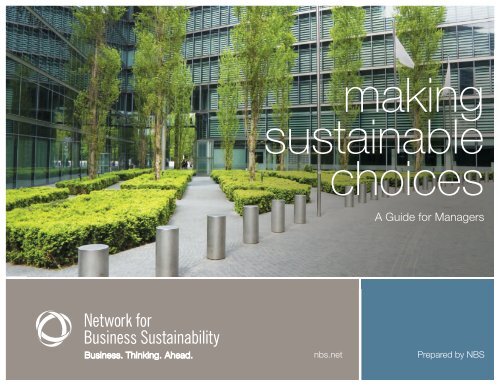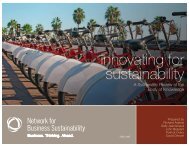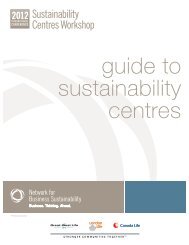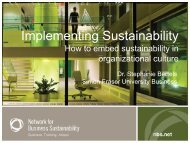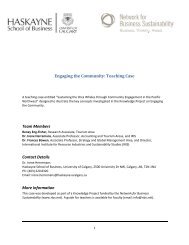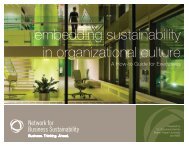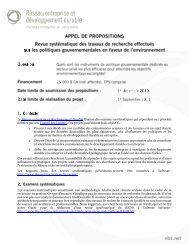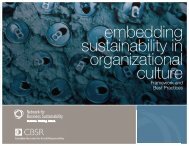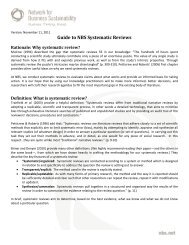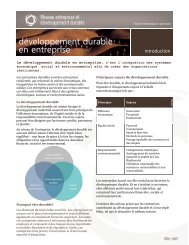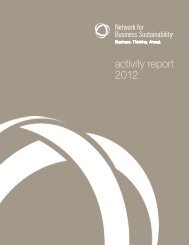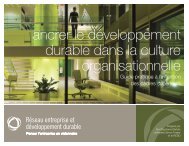A Guide for Managers - Network for Business Sustainability
A Guide for Managers - Network for Business Sustainability
A Guide for Managers - Network for Business Sustainability
You also want an ePaper? Increase the reach of your titles
YUMPU automatically turns print PDFs into web optimized ePapers that Google loves.
making<br />
sustainable<br />
choices<br />
nbs.net<br />
A <strong>Guide</strong> <strong>for</strong> <strong>Managers</strong><br />
Prepared by NBS
<strong>Managers</strong> face<br />
many decisions,<br />
but they often make<br />
unsustainable<br />
choices.<br />
Making Sustainable Choices: A <strong>Guide</strong> <strong>for</strong> <strong>Managers</strong> 2
How can we<br />
encourage individuals<br />
in organizations<br />
to make more<br />
sustainable choices?<br />
Making Sustainable Choices: A <strong>Guide</strong> <strong>for</strong> <strong>Managers</strong> 3
Making Sustainable Choices: A <strong>Guide</strong> <strong>for</strong> <strong>Managers</strong> 4
making sustainable<br />
choices<br />
A guide <strong>for</strong> managers<br />
This report is based on a systematic review conducted by Joseph Arvai, Victoria<br />
Campbell-Arvai and Piers Steel (all of the University of Calgary). The research<br />
team reviewed more than 60 years of research on decision-making. They<br />
identified common biases and errors that inhibit our ability to arrive at more<br />
sustainable choices, both as organizations and individuals. You can make better<br />
decisions by being aware of these common decision biases and errors, and<br />
knowing how to overcome them – or making them work in your favour.<br />
Understanding why we do or do not engage in sustainable behaviour can be<br />
addressed from a variety of research perspectives; <strong>for</strong> example, through research<br />
on values, beliefs and norms. This report was specifically based on research<br />
that sought to understand and support actual decision-making behaviour<br />
(as opposed to attitudes or intentions to per<strong>for</strong>m a particular behaviour).<br />
Further resources available at nbs.net<br />
© 2012, <strong>Network</strong> <strong>for</strong> <strong>Business</strong> <strong>Sustainability</strong><br />
This work is protected under international copyright law. It may not be reproduced or distributed <strong>for</strong> commercial<br />
purposes without the expressed, written consent of the <strong>Network</strong> <strong>for</strong> <strong>Business</strong> <strong>Sustainability</strong>. When using this<br />
work in any way, you must always recognize the <strong>Network</strong> <strong>for</strong> <strong>Business</strong> <strong>Sustainability</strong> using the following citation:<br />
<strong>Network</strong> <strong>for</strong> <strong>Business</strong> <strong>Sustainability</strong>. 2012. Making Sustainable Choices: A <strong>Guide</strong> <strong>for</strong> <strong>Managers</strong>.<br />
<strong>Network</strong> <strong>for</strong> <strong>Business</strong> <strong>Sustainability</strong>. Retrieved from: www.nbs.net/knowledge<br />
Making Sustainable Choices: A <strong>Guide</strong> <strong>for</strong> <strong>Managers</strong> 5
each sustainable outcomes<br />
through better decisions<br />
A manager confronts a number of decisions daily,<br />
ranging from whether to turn off lights to what<br />
benefits to confer on employees. How does she<br />
choose among the array of options to get to the<br />
most sustainable outcome? By understanding the<br />
decision-making process, staff and management<br />
can be encouraged to act more responsibly. This<br />
report provides insights into how decisions are made<br />
and how sustainable choices can be reached.<br />
This research is most relevant <strong>for</strong>:<br />
• <strong>Sustainability</strong> managers looking to encourage<br />
better choices by their employees or customers<br />
(e.g. reducing energy usage, recycling waste).<br />
• Executives seeking ways to create more<br />
transparent, inclusive processes <strong>for</strong> making<br />
major decisions (e.g. where to site a new facility,<br />
reclaiming land).<br />
• Policy-makers in the public or private sector<br />
looking to enable sustainable choices.<br />
This guide can help you:<br />
1. Understand how sustainability decisions<br />
are – and aren’t – like other decisions.<br />
2. Identify the decisions that are most<br />
susceptible to biases.<br />
3. Translate decisions into actions.<br />
4. Create more transparent processes<br />
<strong>for</strong> making complex decisions.<br />
Making Sustainable Choices: A <strong>Guide</strong> <strong>for</strong> <strong>Managers</strong> 6
Are sustainability decisions like other decisions?<br />
Yes and no. To answer the question, we need<br />
to know how we make decisions.<br />
How are decisions made? Economic models<br />
assume people have access to all in<strong>for</strong>mation,<br />
can process it all, and are not victim to errors<br />
and biases. This simply isn’t reality.<br />
People use biases to “help” make decisions quickly<br />
and easily. While these biases simplify complexity<br />
and gain efficiency, they do not always result in the<br />
Figure 1 GETTING TO A SUSTAINABLE OUTCOME<br />
DECISION<br />
POINT<br />
INTERVENTIONS<br />
best long-term solution to a particular question or<br />
problem. For the most part, these shortcuts serve us<br />
well in our day-to-day lives. For example, choosing<br />
to remain with a vendor or particular product line<br />
because it has per<strong>for</strong>med well in the past can yield<br />
an outcome that is “good enough” by many<br />
objective standards. But in other cases, remaining<br />
with the status quo can prevent us from acting in a<br />
manner that better accounts <strong>for</strong> sustainability<br />
considerations (or at the very least in a manner that<br />
best serves our self interest).<br />
When faced with a decision point, individuals must consider a range of more and less<br />
sustainable options. But built-in biases can push individuals towards choices that are<br />
less sustainable. Interventions can help individuals overcome or leverage biases to get<br />
to sustainable outcomes.<br />
? BIASES<br />
unsustainable<br />
outcome<br />
sustainable<br />
outcome<br />
unsustainable<br />
outcome<br />
Making Sustainable Choices: A <strong>Guide</strong> <strong>for</strong> <strong>Managers</strong> 7
?<br />
What sustainability-related decisions do we make?<br />
A sustainability officer is tasked with finding ways to encourage employees to reduce office waste.<br />
A health and safety officer in a manufacturing company is looking to address a broad array of<br />
health, environmental and economic considerations when remediating and reclaiming the grounds<br />
of an old facility.<br />
A director in a non-governmental organization is seeking to increase the adoption of energyefficiency<br />
measures among homeowners.<br />
A team of managers at a large university is considering several options to power their campus –<br />
but how to choose among them to ensure that environmental, economic, educational and social<br />
objectives are met?<br />
So how are sustainability decisions different from other decisions? <strong>Sustainability</strong> decisions can be<br />
subject to specific biases more often than other decisions, such as preference <strong>for</strong> the status quo or<br />
the tendency to choose “wants” over “shoulds”. By understanding which biases crop up again and<br />
again, you can manage or leverage them.<br />
Making Sustainable Choices: A <strong>Guide</strong> <strong>for</strong> <strong>Managers</strong> 8
?<br />
Q<br />
Four categories of biases and errors that are particularly salient to sustainability decisions are<br />
described in detail in Table 1. These may cause decision-makers to consistently and predictably<br />
land on less-sustainable outcomes.<br />
Table 1 BIASES AND ERRORS THAT COME INTO PLAY WHEN MAKING SUSTAINABILITY DECISIONS<br />
Decision Biases & Errors What happens? For example...<br />
loss<br />
avoidance<br />
short-cuts<br />
intuition<br />
“wants” vs “shoulds”<br />
We judge gains and losses relative<br />
to our present state. We don’t like<br />
to give up things we already have<br />
We focus on in<strong>for</strong>mation that’s<br />
familiar, recent or easy to interpret<br />
– even if it’s not very relevant<br />
We over-rely on gut feeling and<br />
intuition when distracted or faced<br />
with new situations<br />
We tend to let “wants” trump<br />
“shoulds” – particularly when we’re<br />
tired or distracted<br />
<strong>Sustainability</strong> decisions may require us to give<br />
up something (even if we get something else<br />
in exchange)<br />
<strong>Sustainability</strong> decisions often use hard-toevaluate<br />
criteria, e.g. recreational benefits or<br />
human health effects, which are trumped by<br />
simple financial metrics<br />
<strong>Sustainability</strong> decisions are often novel, so<br />
individuals may struggle to process all<br />
relevant factors and rely instead on intuition<br />
<strong>Sustainability</strong> decisions may yield longer-term<br />
paybacks, falling into the category of<br />
“shoulds” rather than “wants”<br />
So what can we do about these biases and errors?<br />
Making Sustainable Choices: A <strong>Guide</strong> <strong>for</strong> <strong>Managers</strong> 9
A<br />
Q<br />
It depends on the type of decision being made<br />
There are two basic types of decisions:<br />
Routine and complex.<br />
Routine decisions. Individuals face numerous<br />
routine decisions. These decisions can happen<br />
at home or work. They tend to be frequent, quick<br />
and do not involve a lot of conscious thought. For<br />
example: recycling a coffee cup or turning on a<br />
light. We can improve our routine decisions (and<br />
those of our employees, friends or families) by<br />
leveraging our built-in biases.<br />
Complex decisions. Individuals or groups<br />
(companies, committees) can face complex<br />
decisions. These decisions tend to be infrequent,<br />
require the synthesis of technical and other<br />
in<strong>for</strong>mation, and involve a great deal riding on<br />
arriving at the “right” decision. For example: deciding<br />
where to site a new facility or investing in climate<br />
adaptation initiatives. Decision support techniques<br />
employed to support complex decisions break these<br />
decisions down into manageable steps and aim to<br />
overcome built-in biases and errors.<br />
Recognize that different types of decision supports<br />
outlined in Table 2 are useful <strong>for</strong> different types<br />
of decisions. Active supports are tools that help<br />
overcome our natural limitations to arrive at the<br />
“right” decision <strong>for</strong> us given the criteria we have<br />
identified (as in Multi-Criteria Decision Analysis)<br />
or to thoughtfully consider a range of competing<br />
objectives and stakeholder perspectives (as in<br />
Structured Decision-Making). In using active<br />
supports we are working against our nature.<br />
Passive supports aim to take advantage of our<br />
natural tendencies to steer us towards particular –<br />
presumably more environmentally or socially<br />
desirable – outcomes (as in commitment,<br />
feedback, defaults and goal-setting).<br />
Research shows past approaches to tackling sustainability issues haven’t always been successful.<br />
The uptake of office efficiency and waste reduction measures is still low and prior ef<strong>for</strong>ts at stakeholder<br />
engagement have sometimes resulted in dissatisfaction with the process and/or outcomes of important<br />
decisions. By using interventions, we can get to better outcomes: <strong>for</strong> instance, the use of feedback has<br />
resulted in four to 12 percent reductions in household energy use (see full report <strong>for</strong> more details).<br />
How can we get more sustainable choices across contexts?<br />
Making Sustainable Choices: A <strong>Guide</strong> <strong>for</strong> <strong>Managers</strong> 10
?<br />
A<br />
Some commonly used and effective interventions are discussed in detail below.<br />
Table 2 identifies the technique, what it means, how it has been used and why it works.<br />
For complex decisions For routine decisions<br />
Table 2 OVERVIEW OF INTERVENTIONS FOR ROUTINE AND COMPLEX DECISIONS<br />
Intervention What it is Example Why it works<br />
commitment<br />
defaults<br />
feedback<br />
goal-setting<br />
structured<br />
decisionmaking<br />
(sdm)<br />
multi-criteria<br />
decision<br />
analysis<br />
(mcda)<br />
Publicly commit (or lock yourself<br />
in) to per<strong>for</strong>ming a sustainable<br />
behaviour in the future<br />
Make a sustainable behaviour<br />
the default (more obvious or<br />
easy) choice<br />
Provide verbal, written or digital<br />
feedback (preferably in real time)<br />
on behaviour outcomes<br />
Set an expected level of<br />
per<strong>for</strong>mance or compliance<br />
<strong>for</strong> a sustainable behaviour<br />
Diagnose the problem with<br />
stakeholder input; break decision<br />
into manageable steps; decision<br />
is based on alternative which<br />
per<strong>for</strong>ms best against decision<br />
criteria; broad input is solicited<br />
at all stages and process is<br />
typically guided by a facilitator<br />
Set decision criteria, weight<br />
criteria and enter criteria into a<br />
computer program which<br />
calculates an overall score <strong>for</strong><br />
each alternative<br />
“Idle-free” campaigns across<br />
Canada: private, commercial,<br />
and municipal drivers publicly<br />
pledge to turn off engines<br />
Energy efficiency initiatives in<br />
which participants must opt out<br />
are more effective<br />
In-home digital displays provide<br />
real-time feedback on electricity<br />
use; can be appliance specific<br />
Office-based efficiency and waste<br />
reduction ef<strong>for</strong>ts begin with a<br />
goal or target <strong>for</strong> these ef<strong>for</strong>ts<br />
A utility company utilizes SDM to<br />
find constructive and sustainable<br />
solutions to competing river use<br />
demands<br />
A municipal authority uses input<br />
from MCDA to decide among<br />
various solid waste management<br />
options – including the siting of<br />
new facilities<br />
For more in<strong>for</strong>mation on the biases above, read the full report.<br />
Public commitment enhances positive<br />
feedback <strong>for</strong> sustainable behaviour –<br />
and provides <strong>for</strong> negative feedback if<br />
you don’t deliver<br />
Defaults and opt-out programs build<br />
on the power of the status quo and<br />
our aversion to losses<br />
Makes long-term costs tangible<br />
and relevant “now”; enhances “<br />
good feelings” of meeting<br />
sustainability goals<br />
Enhances the meaning of feedback<br />
by providing a benchmark against<br />
which to judge progress<br />
Decisions are seen as an opportunity<br />
to clearly identify objectives, include<br />
diverse perspectives and deal with<br />
tough trade-offs; avoids solutions that<br />
are attractive only because they are<br />
obvious or easy, or because it’s the<br />
“way it has always been done”<br />
Reduces complex, diverse info<br />
about options to a single score;<br />
decision options are ranked according<br />
to those scores and the decisionmaker<br />
can choose the option with<br />
the highest score<br />
Making Sustainable Choices: A <strong>Guide</strong> <strong>for</strong> <strong>Managers</strong> 11
Figure 2 shows how a manager might decide on a strategy <strong>for</strong> getting<br />
to a more sustainable decision in a particular situation:<br />
1. Is the decision complex or routine?<br />
2. What are the characteristics of the decision and context that need to be addressed?<br />
3. Which interventions are most likely to assist in getting to a more sustainable outcome?<br />
Figure 2 OVERVIEW OF DECISION SUPPORT TECHNIQUES FOR ROUTINE AND COMPLEX DECISIONS<br />
Making Sustainable Choices: A <strong>Guide</strong> <strong>for</strong> <strong>Managers</strong> 12
MCDA or SDM: Which is right <strong>for</strong> your organization?<br />
<strong>Sustainability</strong> managers may consider implementing<br />
some version of either Structured Decision-Making or<br />
Multi-Criteria Decision Analysis to consistently improve<br />
the way their organizations make complex decisions.<br />
Both SDM and MCDA can be applied across a range<br />
of situations – and in fact SDM and MCDA share many<br />
of the same theoretical principles. It’s worth noting that<br />
these methods have gained some popularity with<br />
organizations that have high needs <strong>for</strong> transparency<br />
and stakeholder involvement (<strong>for</strong> instance, government<br />
agencies and quasi-private corporations). The general<br />
characteristics of each are identified below:<br />
Allows <strong>for</strong> the complexity inherent in<br />
sustainability issues<br />
Weights decision criteria and ranks<br />
possible outcomes<br />
Builds in mechanisms to help make tough<br />
trade-offs<br />
Brings rigour to the decision-making process<br />
Uses mathematical models and computer<br />
algorithms to rank solutions from best to worst<br />
Focuses on building legitimacy and trust<br />
through the process<br />
Views decision-making as an opportunity to<br />
meaningfully incorporate stakeholder values<br />
throughout the process<br />
Brings transparency to the decisionmaking<br />
process<br />
SDM MCDA<br />
In choosing whether to consider implementing active<br />
decision supports in your organization, recognize<br />
that either approach can represent a significant<br />
investment of time and other resources. These tools<br />
are best used not as solutions to a single problem,<br />
but as consistently applied organizational<br />
approaches to addressing a range of decisions.<br />
Making Sustainable Choices: A <strong>Guide</strong> <strong>for</strong> <strong>Managers</strong> 13
In practice: Structured Decision-Making at BC Hydro<br />
BC Hydro is one of Canada’s largest electric<br />
utilities, serving 95 percent of British Columbia<br />
residents. The provincial crown corporation has<br />
long considered environmental and social factors<br />
alongside economic factors as part of its approach<br />
to doing business. But it was clear from the outset<br />
that trade-offs would have to be made if decisions<br />
were to incorporate all three factors.<br />
“BC Hydro had set an objective of being a<br />
sustainable energy company,” says Brenda<br />
Goehring, Manager, Corporate Environment &<br />
<strong>Sustainability</strong>. “But the challenge we faced was<br />
how we could operationalize that thinking across<br />
the organization.” Though BC Hydro had been<br />
incorporating the three priorities into its processes<br />
since the mid-1990s, it realized a more <strong>for</strong>mal<br />
SAMPLE CONSEQUENCE TABLE FOR SDM<br />
Objectives What happens? Option A Option B Option C<br />
Maximize financial<br />
return<br />
Minimize area of<br />
disturbed wetland<br />
Minimize risk of<br />
contaminated soil<br />
Maximize reliability to<br />
customers<br />
Net present value ($)<br />
Area impacted wetland (ha)<br />
Example<br />
Max. potential soil<br />
contamination (index)<br />
Length of line near tall<br />
trees (km)<br />
$1,000,000<br />
10 ha<br />
(+/- 2 ha)<br />
Medium<br />
14 km<br />
$1,250,000<br />
6 ha<br />
(+/- 1 ha)<br />
Medium<br />
16 km<br />
$850,000<br />
4 ha<br />
(+/- 1 ha)<br />
High<br />
22 km<br />
NOTE: In this example, we are comparing Options B and C to Option A.<br />
The colours highlight the trade-offs.<br />
approach was necessary and established crossorganizational<br />
Structured Decision-Making (SDM)<br />
in 2008. SDM helps companies manage competing<br />
objectives, complexity and stakeholders, and<br />
involves a five-step process (following the acronym<br />
PrOACT): defining the Problem, specifying<br />
Objectives and measures, creating Alternatives,<br />
identifying Consequences and clarifying Trade-offs.<br />
This process is summarized <strong>for</strong> BC Hydro<br />
employees in Structured Decision-Making in a<br />
Page. This resource outlines the PrOACT framework<br />
and prompts decision-makers to consider such<br />
questions as: “Were the appropriate people involved<br />
in the process?” and “Do the alternatives include<br />
creative solutions, challenging perceived constraints<br />
and combining elements in thoughtful ways?”<br />
Making Sustainable Choices: A <strong>Guide</strong> <strong>for</strong> <strong>Managers</strong> 14
SDM has numerous benefits. “It’s scalable and you<br />
can apply it to something straight<strong>for</strong>ward or multifaceted,”<br />
says Goehring. “SDM creates rigour and<br />
discipline whether the question involves assessing<br />
alternatives <strong>for</strong> bottled water use by line crews or<br />
making six-figure procurement decisions.” Has<br />
SDM led to better outcomes? Yes, says Goehring,<br />
who explains the process allows people to take a<br />
different perspective on options under<br />
consideration. It <strong>for</strong>ces decision-makers to look<br />
beyond the usual engineering or technical solution<br />
to see how other corporate objectives can be met.<br />
“The process helps us take a long-term view, which<br />
leads to new and more thoughtful alternatives,”<br />
Goehring notes. “It also highlights gaps in<br />
knowledge, which means we can go out and get<br />
more in<strong>for</strong>mation.” It has also raised awareness<br />
that rigour and transparency are important in the<br />
company, and expected <strong>for</strong> long-term decisions.<br />
Having the process in place has enabled better<br />
discussions and support <strong>for</strong> decisions, as well as<br />
improved organizational consistency.<br />
Companies looking to develop an SDM framework<br />
should understand there’s an investment upfront.<br />
But according to Goehring, “eventually the<br />
framework becomes just another step in the<br />
business process. For BC Hydro, it was about<br />
getting a framework that could work <strong>for</strong> experts<br />
and non-experts alike.” One key success factor <strong>for</strong><br />
BC Hydro was getting employees involved from the<br />
outset and letting their interest drive development<br />
and adoption of the new framework.<br />
Example<br />
In 2008, BC Hydro was reviewing<br />
its hydro pole procurement. The<br />
company took into account a range<br />
of factors when considering the type<br />
of wood used, including reliability of<br />
supply, quality and safety. It ultimately<br />
decided to source cedar poles rather<br />
than pine ones. Though pine was<br />
cheaper, it was more prone to rot<br />
and the supply was at risk due to<br />
BC mountain pine beetle infestation.<br />
And, pine poles require more chemical<br />
treatment, meaning more complex endof-life<br />
disposal and less wood to be<br />
recycled. Considering all of these<br />
factors – not just the upfront cost –<br />
BC Hydro estimates it will save $110<br />
million over 60 years as a result of<br />
the decision to source cedar poles.<br />
For a more detailed discussion of BC Hydro’s SDM, please visit Industry Canada’s case study and outline of the<br />
PROACT process. http://www.ic.gc.ca/eic/site/csr-rse.nsf/eng/h_rs00564.html<br />
Making Sustainable Choices: A <strong>Guide</strong> <strong>for</strong> <strong>Managers</strong> 15
about the research<br />
This research was inspired by the NBS Leadership Council, which gathers annually to identify the top<br />
sustainability challenges <strong>for</strong> business. This report is an extension of a larger systematic review authored by<br />
Dr. Joseph Arvai, Dr. Victoria Campbell-Arvai and Dr. Piers Steel which reviewed 207 relevant sources over<br />
more than 60 years. Using this set of sources, the researchers conducted extensive, detailed analysis and<br />
synthesis of the materials to provide insight as to why individuals find it difficult to balance social, economic<br />
and environmental considerations when making decisions. The team also outlined the two main types of<br />
decisions, the tools that can help improve decision-making and the characteristics that define when each<br />
approach is most appropriate. The full systematic review is available here.<br />
NBS gratefully acknowledges the input of the following individuals into this executive report: Andrea Baldwin<br />
(SECOR), Debbie Baxter (LoyaltyOne), Karen Clarke-Whistler (TD Bank Group), Monica DePlante (World<br />
Wildlife Fund), Brenda Goehring (BC Hydro), Diane Kilcoyne (Canadian Tire), Pong Leung (The Natural Step),<br />
Heather Mak (SustainAbility), Matthew McCulloch (The Pembina Institute), Rob Moore (Canadian <strong>Business</strong> <strong>for</strong><br />
Social Responsibility), David Smith (Sobeys) and Bob Willard (The <strong>Sustainability</strong> Advantage). Note: This report<br />
is authored exclusively by the <strong>Network</strong> <strong>for</strong> <strong>Business</strong> <strong>Sustainability</strong>, and does not necessarily reflect the views<br />
of the a<strong>for</strong>ementioned individuals or their organizations.<br />
Making Sustainable Choices: A <strong>Guide</strong> <strong>for</strong> <strong>Managers</strong> 16
about NBS<br />
A Canadian non-profit, the <strong>Network</strong> <strong>for</strong> <strong>Business</strong> <strong>Sustainability</strong> produces authoritative resources on important<br />
sustainability issues with the goal of changing management practice. We unite thousands of researchers and<br />
professionals worldwide who believe passionately in research-based practice and practice-based research.<br />
NBS is funded by the Social Sciences and Humanities Research Council of Canada, the Richard Ivey School of<br />
<strong>Business</strong> (at The University of Western Ontario), the Université du Québec à Montréal and our Leadership Council.<br />
NBS Knowledge Centre<br />
For additional resources visit the Knowledge Centre at nbs.net/knowledge.<br />
Read other NBS Executive Reports:<br />
• Building Effective Environmental Policy<br />
• Embedding <strong>Sustainability</strong> in Organizational Culture<br />
• Managing Sustainable Global Supply Chains<br />
• Measuring and Valuing Environmental Impacts<br />
NBS Leadership Council<br />
NBS’s Leadership Council is a group of Canadian sustainability leaders from diverse sectors. At an annual meeting,<br />
these leaders identify their top priorities in business sustainability – the issues on which their organizations need<br />
authoritative answers and reliable insights. Their sustainability priorities prompt NBS research projects.<br />
This research was funded in part by the Social Sciences and Humanities Research Council of Canada.<br />
Making Sustainable Choices: A <strong>Guide</strong> <strong>for</strong> <strong>Managers</strong> 17
<strong>Network</strong> <strong>for</strong> <strong>Business</strong> <strong>Sustainability</strong><br />
c/o Richard Ivey School of <strong>Business</strong><br />
University of Western Ontario<br />
1151 Richmond Street<br />
London, Ontario, Canada N6A 3K7<br />
519-661-2111 x88932<br />
50 copies<br />
Contains FSC certified 100% post-consumer fibre<br />
Certified EcoLogo, Processed Chlorine Free and FSC Recycled<br />
Manufactured using biogas energy<br />
Printed on Rolland Enviro Smooth 80# Text<br />
Printed digitally to reduce waste<br />
Réseau entreprise et développement durable<br />
École des Sciences de la gestion<br />
Université du Québec à Montréal<br />
1290, rue Saint-Denis, 6e étage, AB-6270<br />
Montréal, Québec, Canada H2X 3J7<br />
514-987-3000 x7898<br />
nbs.net<br />
nbs.net/fr


